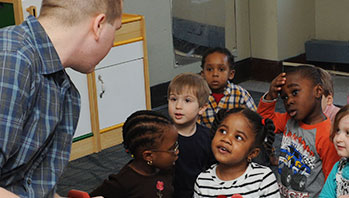- chart paper
- marker
- loud
- quiet
MA Standards:
Speaking and Listening/SL.PK.MA.1: Participate in collaborative conversations with diverse partners during daily routines and play.
Language/L.PK.MA.1: Demonstrate use of oral language in informal everyday activities.t
MA Draft STE Standards:
Physical Sciences/Matter and Its Interactions/PS4.B: Apply their understanding in their play of how to change volume and pitch of some sounds.
Head Start Outcomes:
Language Development/Receptive Language: Attends to language during conversations, songs, stories, or other learning experiences.
Language Development/Expressive Language: Uses language to express ideas and needs.
PreK Learning Guidelines:
English Language Arts/Language 2: Participate actively in discussions, listen to the ideas of others, and ask and answer relevant questions.
Science and Technology/Living Things and Their Environment 15: Use their senses of sight, hearing, touch, smell, and taste to explore their environment using sensory vocabulary.
Talk Together: Loud and Quiet

© Commonwealth of Massachusetts, Department of Early Education and Care (Jennifer Waddell photographer). All rights reserved.
STEM Key Concepts: Sounds have a source; Sound is caused by vibration; An action has to happen to make a sound; Different objects make different sounds; Sounds vary in three ways: volume, pitch, and timbre
ELA Focus Skills: Speaking and Listening, Vocabulary
Educator Prep: Prepare a two-column chart. Label columns "Loud" and "Quiet" and title the chart "Loud and Quiet Sounds." Display for children to use in the discussion.
Introduce loud and quiet.
In a loud voice ask, Who can describe the voice I am using now? Elicit you are using a loud voice and then tell children you want them to think about something that makes a loud sound.
- Have them share their ideas.
- Then have them write, draw, or dictate the response in the "Loud" column of the chart.
Then say in a quiet voice, Now think about the sound a purring cat makes. Ask, Does it make a loud or a quiet sound? A whisper? Have volunteers write, draw, or dictate the response in the "Quiet" column on the chart.
Then demonstrate speaking in a loud voice again. Ask children if they have ever heard you use that loud voice before. Discuss why you might use your loud voice (to keep someone safe, to call someone far away, when there was too much noise for children to hear your regular voice, etc.).
- Ask children to share a time they have used a loud voice and explain why.
- Repeat activity with a quiet voice. Record ideas on the chart.
Social Emotional Tip: Talk with children about using a quiet voice in some places, like a library, and how it is an important way of behaving respectfully.
